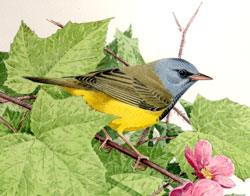Breeding Bird Atlases (BBA)
Find a Bird - BBA1
Breeding Bird Atlas 1 Species Accounts
Mourning Warbler
Oporornis philadelphia
Egg Dates
not available
Number of Broods
one

This handsome bird is regarded as one of the rarest of the warblers occurring regularly in Massachusetts. The opinion is in part due to the bird’s shyness, its fondness for skulking in dense briers and other shrubbery, and its arrival later in the spring than most birds, at a time when the foliage is often fully developed.
The Mourning Warbler received its scientific name because Alexander Wilson discovered the type specimen near Philadelphia. He never saw another, and Audubon encountered few. The male does wear a veil of crepe, but, as Edward Howe Forbush pointed out, this is the only thing about the bird that would suggest mourning, calling its song “a paean of joy.”
Like other members of its genus, the Mourning Warbler has a loud, penetrating song, often described as chirry, chirry, chory, chory. Some of the less typical notes can be confused with the song of the Common Yellowthroat. The Mourning Warbler’s alarm note is a distinctive, sharp chip.
Mourning Warblers were first discovered at 3,491 feet on Mount Greylock in the summer of 1883 by William Brewster, who termed them “abundant.” They have been seen there ever since, although in diminishing numbers, probably as a result of the maturing of the sprout growth on the upper mountain. During the 1940s and 1950s, from two to eight singing males occurred along the upper portions of the roads leading to the summit. Today, possibly as a result of the enormous increase in auto traffic, Mourning Warblers are now more likely to be found lower down, especially where slash growth occurs. In recent summers, birds have been seen as low as 1,500 feet along Rockwell and Notch roads, and, in 1983, males were found in July as low as 1,200 feet in the Hopper, on the west side of Mount Greylock.
Historically, Mourning Warblers also occurred in North Adams, Savoy, and Florida. In recent summers, they have been located in Cheshire, Dalton, and Hancock. All locations are in northern Berkshire County at an elevation greater than 1,500 feet.
Spring migrants may appear as early as the second week of May, but the bulk of the birds do not arrive until the end of the month or the first week of June. Some of the latter are probably northbound transients. Males establish territories in clearings overgrown with weeds, bushes, briers, and small saplings, often with fallen logs and branches forming a virtually impenetrable tangle. The male’s song may be the only clue to the presence of the species because both sexes are very shy and retiring and generally keep themselves well hidden in dense vegetation.
The nest is located on the ground in a weed clump or slightly higher in dense shrubby vegetation. It is a bulky structure, the outer part comprised of leaves, grass, and bark, with the cup lined with finer grasses, rootlets, and hairs. The clutch size varies from three to five eggs, with four eggs being average. The eggs are incubated solely by the female for about 12 days. The young leave the nest about 10 days after hatching and are tended by both parent birds for several weeks.
Migration commences by mid-August and continues through September with the passage of more northerly breeders. Stragglers are sometimes noted in early October. Fall migrants may join other thicket-dwelling species but in general are inconspicuous and easily overlooked. The Mourning Warbler winters from southern Nicaragua south to Colombia, eastern Ecuador, and south- ern Venezuela.
The Mourning Warbler is listed as a species of special concern in Massachusetts.
Map Legend and Data Summary
Atlas 1 data collected from 1975-1979


Note: rare and local in dense shrubby undergrowth of higher elevations in Berkshire Country
Bartlett Hendricks



